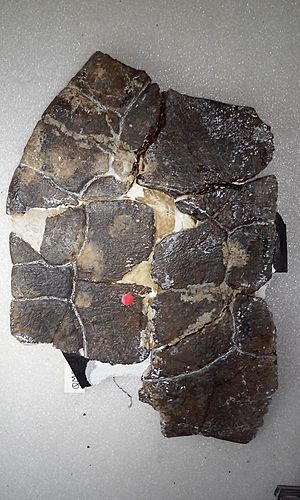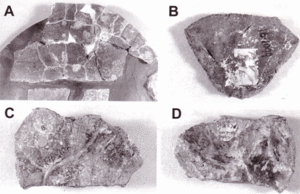Elseya uberrima facts for kids
Quick facts for kids Elseya uberrimaTemporal range: Eocene
|
|
|---|---|
 |
|
| Scientific classification | |
| Genus: |
Elseya
|
| Species: |
uberrima
|
Elseya uberrima was an extinct species of snapping turtle that lived a very long time ago during the Eocene epoch. This ancient turtle once roamed the lands of Australia.
Contents
Discovering Elseya uberrima
Scientists study fossils to learn about animals that lived in the past. Elseya uberrima is known only from its fossils. These fossils help us understand what this ancient turtle looked like.
Who Found the Fossils?
A scientist named Charles Walter De Vis first described some of these turtle fossils. He worked at the Queensland Museum in Australia. He found these ancient turtle remains in a place called Darling Downs in Queensland.
Naming the Ancient Turtle
When De Vis first found these fossils, he thought they belonged to several different turtle species. He gave them different names, such as Chelymys uberrima and Pelocomastes ampla.
However, later studies showed that all these fossils were actually from the same type of turtle. In 2000, another scientist named Thomson confirmed this. So, all those different names became synonyms for one species: Elseya uberrima.
- Elseya uberrima (De Vis, 1897)
- Chelymys uberrima De Vis, 1897
- Chelymys antiqua De Vis 1897
- Chelymys arata De Vis 1897
- Pelocomastes ampla De Vis 1897
What is a Subgenus?
Scientists group animals into categories to show how they are related. A genus is a group of closely related species. For example, all modern snapping turtles in Australia belong to the genus Elseya.
Sometimes, a genus can be very large. So, scientists use a smaller group called a subgenus. It helps them organize species within a genus even more. In 2015, scientists decided to bring back the name Pelocomastes as a subgenus. This subgenus now includes Elseya uberrima and other related turtles from Queensland.
So, the full scientific name for this ancient turtle is Elseya (Pelocomastes) uberrima. It means it's an Elseya turtle, but it belongs to the Pelocomastes subgenus.


